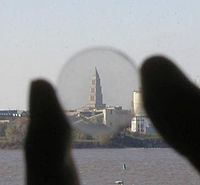
Effects of oblique angle deposition on structural, electrical and wettability properties of Bi thin films grown by thermal evaporation
Sign Up to like & getrecommendations! Published in 2019 at "Applied Surface Science"
DOI: 10.1016/j.apsusc.2018.08.200
Abstract: Abstract Oblique angle deposition is a promising technique for tuning the physical properties of thin films. Structural, surface morphology, electrical and wettability properties are strongly influenced by the angle of deposition. A comparison of these… read more here.
Keywords: obliquely deposited; film; properties thin; deposition ... See more keywords

Towards perfect MWIR transparency using oblique angle deposition
Sign Up to like & getrecommendations! Published in 2019 at "Applied Surface Science"
DOI: 10.1016/j.apsusc.2018.11.176
Abstract: Abstract This work reports the development of a perfect antireflective coating designed to operate over the 3.7–4.8 µm MWIR region, in order to improve the optics used in thermal detection systems. A simulated stack with 99.97%… read more here.
Keywords: perfect mwir; angle deposition; oblique angle; towards perfect ... See more keywords

Growth and roughness dependent wetting properties of CeO2 films prepared by glancing angle deposition
Sign Up to like & getrecommendations! Published in 2018 at "Ceramics International"
DOI: 10.1016/j.ceramint.2018.02.206
Abstract: Abstract Robust hydrophobic materials based on ceramic are capable of withstanding harsh conditions such as erosion, abrasion and high temperature. The wetting performance of a ceramic film is strongly dependent on the surface morphology. In… read more here.
Keywords: angle deposition; glancing angle; ceo2 films; deposition ... See more keywords

Controlling the charge transport mode in permalloy films using oblique angle deposition
Sign Up to like & getrecommendations! Published in 2019 at "Journal of Magnetism and Magnetic Materials"
DOI: 10.1016/j.jmmm.2019.03.087
Abstract: Abstract We have systematically studied the effect of oblique angle deposition (OAD) on the transport properties of Permalloy (Ni81Fe19) thin films. Films deposited at oblique angles larger than 50° exhibit a resistivity minimum that can… read more here.
Keywords: oblique angle; controlling charge; charge transport; angle deposition ... See more keywords

Study of magnetic nanowires of amorphous Co20Fe60B20 prepared by oblique angle deposition on nanorippled substrate
Sign Up to like & getrecommendations! Published in 2021 at "Journal of Magnetism and Magnetic Materials"
DOI: 10.1016/j.jmmm.2021.167842
Abstract: Abstract An array of magnetic nanowires of amorphous Co20Fe60B20 alloy has been prepared by oblique angle deposition of material on nanorippled substrate. The angle of incidence is chosen such that the deposition takes place on… read more here.
Keywords: nanowires amorphous; amorphous co20fe60b20; magnetic nanowires; deposition ... See more keywords

Preparation of highly hydrophobic CeO2 films using glancing angle deposition
Sign Up to like & getrecommendations! Published in 2018 at "Materials Letters"
DOI: 10.1016/j.matlet.2018.01.006
Abstract: Abstract Atomic shadowing during kinetically limited physical vapor deposition usually causes the formation of one-dimensional nanostructures with novel shapes. In this letter, we report the variety of surface topography and shapes of columns of CeO2… read more here.
Keywords: angle deposition; glancing angle; ceo2 films; deposition ... See more keywords

Modification of hydrophobicity properties of diamond like carbon films using glancing angle deposition method
Sign Up to like & getrecommendations! Published in 2018 at "Materials Letters"
DOI: 10.1016/j.matlet.2018.03.060
Abstract: Abstract We report the effect of glancing angle deposition (GLAD) method on hydrophobicity properties of diamond like carbon (DLC) films. DLC films were manufactured using direct ion beam method by methane (CH4) precursor gas at… read more here.
Keywords: angle deposition; glancing angle; method; deposition ... See more keywords

Glancing Angle Deposition of Large-Scale Helical Si@Cu3Si Nanorod Arrays for High-Performance Anodes in Rechargeable Li-Ion Batteries
Sign Up to like & getrecommendations! Published in 2021 at "Nanoscale"
DOI: 10.1039/d1nr05297g
Abstract: Silicon (Si) anode materials have attracted substantial interest due to its high theoretical capacity. Here, the growth of helical Si@Cu3Si nanorod arrays via glancing angle deposition (GLAD) followed by an... read more here.
Keywords: glancing angle; angle deposition; helical cu3si; cu3si nanorod ... See more keywords

Oblique angle deposition of boron carbide films by magnetron sputtering
Sign Up to like & getrecommendations! Published in 2021 at "Journal of Applied Physics"
DOI: 10.1063/5.0056849
Abstract: Many applications of boron carbide ( B4C) films entail deposition on non-planar substrates, necessitating a better understanding of oblique angle deposition phenomena. Here, we systematically study the effect of substrate tilt on properties of B4C… read more here.
Keywords: boron carbide; magnetron sputtering; angle deposition; deposition ... See more keywords

Opto-electrical characterization of quaternary sputtered copper indium gallium selenide nanorods via glancing angle deposition
Sign Up to like & getrecommendations! Published in 2020 at "Journal of Vacuum Science and Technology"
DOI: 10.1116/6.0000382
Abstract: Nanorod arrays have become an attractive alternative to their thin film and bulk counterparts in photovoltaic and photoconductivity research. This is mainly attributed to their superior optical and electrical properties. Light trapping and unique bandgap… read more here.
Keywords: optical absorption; angle deposition; glancing angle; deposition ... See more keywords

Glancing angle deposition meets colloidal lithography: a new evolution in the design of nanostructures
Sign Up to like & getrecommendations! Published in 2018 at "Nanophotonics"
DOI: 10.1515/nanoph-2018-0105
Abstract: Abstract The combination of colloidal lithography and glancing angle deposition facilitates a new powerful fabrication technique – shadow sphere lithography (SSL), which can greatly expand the variety and complexity of nanostructures fabricated using simple evaporation… read more here.
Keywords: angle deposition; glancing angle; colloidal lithography; deposition meets ... See more keywords